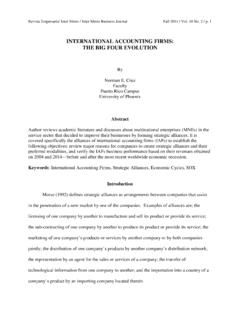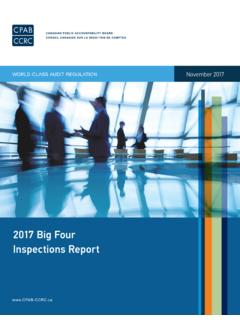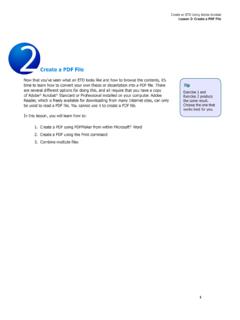Transcription of The Big Four Economic Indicators: Industrial Production Up ...
1 The big four - Industrial Production : Up JuneJuly 15, 2021by Jill Mislinskiof Advisor PerspectivesNote: This commentary has been updated to incorporate the June data for Industrial recession calls are the responsibility of the NBER Business Cycle Dating Committee, which isunderstandably vague about the specific indicators on which they base their decisions. This committeestatement is about as close as they get to identifying their is, however, a general belief that there are four big indicators that the committee weighs heavily intheir cycle identification process. They are:Nonfarm EmploymentIndustrial ProductionReal Retail SalesReal Personal Income (excluding Transfer Receipts)The Latest Indicator DataToday's report on Industrial Production for June shows a increase month-over-month, which wasbelow the consensus of The year-over-year change is , down from last month'sYoY increase.
2 Annual revisions were is the overview from the Federal Reserve: Industrial Production increased percent in June after moving up percent in May. In June,manufacturing output edged down percent, as an ongoing shortage of semiconductors contributedto a decrease of percent in the Production of motor vehicles and parts. Excluding motor vehiclesand parts, factory output increased percent. The output of utilities advanced percent,reflecting heightened demand for air conditioning, as much of the country experienced a heat wave inJune. The index for mining increased the second quarter as a whole, total Industrial Production rose at an annual rate of output increased at an annual rate of percent despite a drop of percent formotor vehicles and percent of its 2017 average, total Industrial Production in June was percent above itsyear-earlier level but percent below its pre-pandemic (February 2020) level.
3 Capacity utilizationfor the Industrial sector rose percentage point in June to percent, a rate that is points below its long-run (1972 2020) average. [view full report]The chart below shows the year-over-year percent change in Industrial Production since the series inceptionin 1919, the current level is lower than at the onset of 5 of 18 recessions over this time frame of nearly 1, 2021 Advisor Perspectives, Inc. All rights UtilizationThe Fed's monthly Industrial Production estimate is accompanied by another closely watched indicator,Capacity Utilization, which is the percentage of US total Production capacity being used (available resourcesincludes manufacturing, mining, and electric and gas utilities). In addition to showing cycles of economicgrowth and demand, Capacity Utilization also serves as a leading indicator of is a chart of the complete Capacity Utilization series, which the Fed began tracking in 1967.
4 The linearregression assists our understanding of the long-term trend. We've highlighted the post-recession peak inNovember 2, 2021 Advisor Perspectives, Inc. All rights latest reading is well below its interim peak and the Generic Big FourThe chart and table below illustrate the performance of the generic big four with an overlay of a simpleaverage of the four since the end of the Great Recession. The data points show the cumulative percentchange from a zero starting point for June 2009. We will update this chart and table to reflect the currentrecession when a real trough is and OutlookPage 3, 2021 Advisor Perspectives, Inc. All rights is a percent-off-high chart based on an average of the big four . The average of the four set a new all-time high in November 2018. April is looking to be the worst month for the big four in terms of the equal-weighted aggregate since 2013.
5 In terms of percent-off highs, this is the big four 's worst in its next update of the big four will be the latest numbers for real retail Analysis: The big four Indicators and RecessionsThe charts above don't show us the individual behavior of the big four leading up to the 2007 recession. Toachieve that goal, we've plotted the same data using a "percent off high" technique. In other words, weshow successive new highs as zero and the cumulative percent declines of months that aren't new advantage of this approach is that it helps us visualize declines more clearly and to compare the depthof declines for each indicator and across time ( , the short 2001 recession versus the Great Recession).Here is our four -pack showing the indicators with this 4, 2021 Advisor Perspectives, Inc. All rights let's examine the behavior of these indicators across time. The first chart below graphs the period from2000 to the present, thereby showing us the behavior of the four indicators before and after the two mostrecent recessions.
6 Rather than having four separate charts, we've created an overlay to help us evaluatethe relative behavior of the indicators at the cycle peaks and troughs. (See the note below on recessionboundaries).The chart above is an excellent starting point for evaluating the relevance of the four indicators in thecontext of two very different recessions. In both cases, the bounce in Industrial Production matches theNBER trough while Employment and Personal Incomes lagged in their respective for the start of these two 21st century recessions, the indicator declines are less uniform in theirbehavior. We can see, however, that Employment and Personal Income were laggards in the let's look at the 1972-1985 period, which included three recessions -- the savage 16-month OilEmbargo recession of 1973-1975 and the double dip of 1980 and 1981-1982 (6-months and 16-months,respectively).Page 5, 2021 Advisor Perspectives, Inc.
7 All rights finally, for sharp-eyed readers who can don't mind squinting at a lot of data, here's a cluttered chartfrom 1959 to the present. That is the earliest date for which all four indicators are available. The mainlesson of this chart is the diverse patterns and volatility across time for these indicators. For example, retailsales and Industrial Production are far more volatile than employment and 6, 2021 Advisor Perspectives, Inc. All rights charts above focus on the big four individually, either separately or overlaid. Now let's take a quicklook at an aggregate of the four . The next chart is an index created by equally weighting the four andindexing them to 100 for the January 1959 start date. We've used a log scale to give an accurate indicationof growth and also added an exponential regression to assist us in seeing the secular patterns of faster andslower growth. As we can readily see, growth of this aggregate indicator has slowed dramatically since theend of the last 7, 2021 Advisor Perspectives, Inc.
8 All rights let's plot the percent off high for this aggregate index. As we immediately recognize, it is completelyworthless as a leading indicator of recessions. The aggregate index set a new high the month before therecession began for five of the eight recessions since the early 8, 2021 Advisor Perspectives, Inc. All rights can construct a better leading indicator by plotting the average of the percent off highs for each of thefour, which is the technique we've used in the next chart. Here we've highlighted the months when all fourindicators were at all-time highs. The dashed line shows the average of the four at recession 9, 2021 Advisor Perspectives, Inc. All rights chart clearly illustrates the savagery of the last recession. It was much deeper than the closestcontender in this timeframe, the 1973-1975 Oil Embargo : Chart Gallery with NotesThe indicator discussed in this article is illustrated below in three different data manipulations:1.
9 A log scale plotting of the complete data series to ensure that distances on the vertical axis reflect truerelative growth. This adjustment is particularly important for data series that have changedsignificantly over A year-over-year representation to help, among other things, identify broader trends over the A percent-off-high manipulation, which is particularly useful for better understanding of trend behaviorand secular ProductionThe US Industrial Production Index (INDPRO) is the oldest of the four indicators, stretching back to 1919,although we've dropped the earlier decades and started in 10, 2021 Advisor Perspectives, Inc. All rights 11, 2021 Advisor Perspectives, Inc. All rights Note on Recessions: Recessions are represented as the peak month through the month preceding thetrough to highlight the recessions in the charts above. For example, the NBER dates the last cycle peak asDecember 2007, the trough as June 2009 and the duration as 18 months.
10 The "Peak through the Periodpreceding the Trough" series is the one FRED uses in its monthly charts, as explained in the FRED FAQsillustrated in this Industrial Production 12, 2021 Advisor Perspectives, Inc. All rights reserved.














